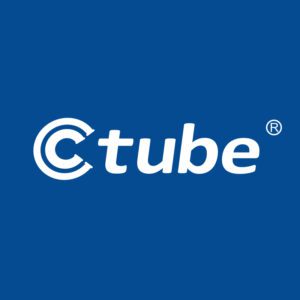جدول المحتويات
تبديل1.Introduction to DB120 Conduit و Schedule 40 Conduit
Choosing the right conduit for electrical installations is crucial for ensuring the safety, efficiency, and longevity of your electrical systems. Conduits serve as protective tubing that encases electrical wiring, safeguarding it from physical damage, moisture, and other environmental factors. They play a vital role in both residential and commercial electrical installations, making the selection of the appropriate conduit type a critical decision for electricians, contractors, and DIY enthusiasts alike.
Among the various types of conduits available, DB120 and Schedule 40 (Sch 40) are two very popular choices, each with distinct characteristics and applications. DB120 conduit, known for its lightweight and flexible nature, is often preferred for specific uses, while Schedule 40, recognized for its robustness and versatility, is widely utilized in a variety of settings. Understanding the differences between these two types of conduits is essential for selecting the one that best fits the requirements of your project.
The primary aim of this article is to provide a comprehensive comparison between DB120 and Schedule 40 conduits. By delving into their specifications, benefits, and typical applications, we seek to equip you with the knowledge needed to make informed decisions regarding conduit selection. Whether you are an electrician working on a complex commercial installation or a homeowner embarking on a DIY project, this guide will help you understand the strengths and limitations of each conduit type.
We will explore key aspects such as material composition, durability, cost, and ease of installation. Additionally, we will highlight specific scenarios where one conduit may be more advantageous than the other. Our goal is to present a balanced and thorough analysis that considers both technical specifications and practical considerations.
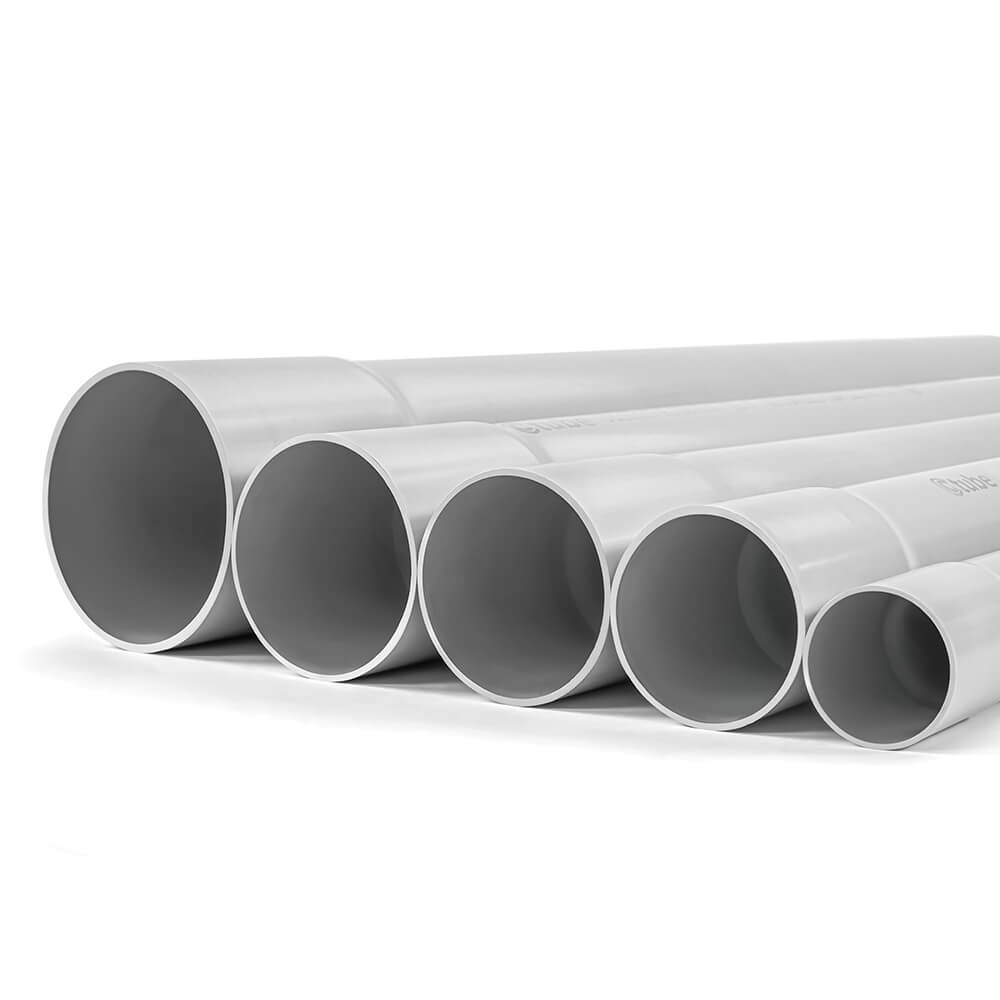
2. Understanding DB120 Conduit: Features and Applications
2.1 What is DB120 Conduit
DB120 conduit is a type of polyvinyl chloride (PVC) conduit specifically designed for underground and direct burial applications. The “DB” stands for “Direct Burial,” and the “120” indicates a specific wall thickness. This type of conduit is known for its lightweight and flexible characteristics, which make it easier to handle and install compared to other heavier-duty conduits.
According to NEMA TC 6 & 8
The PVC duct specified in this Standard is intended for installation underground for communications and electrical wire and cable:
Type EB-20 Designed for burial encased in concrete
Type EB-35 Designed for burial encased in concrete
Type DB-60 Designed for direct burial without encasement in concrete
Type DB-100 Designed for direct burial without encasement in concrete
Type DB-120 Designed for direct burial without encasement in concrete
Type DB products can also be used for concrete encased applications where specified.
2.2 Material and Design Specifics
– Material: DB120 conduit is made from high-quality polyvinyl chloride (PVC), a durable and versatile thermoplastic material. PVC is chosen for its excellent properties, including high resistance to chemicals, moisture, and corrosion. This resistance ensures that the conduit can withstand harsh underground environments, protecting the enclosed cables from various forms of degradation.
– Design: The conduit features a smooth interior surface that minimizes friction, allowing for easy pulling of wires through long sections. This smooth interior is crucial for preventing damage to cables during installation, reducing the likelihood of snags or abrasions. Additionally, DB120 conduit often comes with a bell end, a flared end that allows sections of conduit to be easily joined together without the need for additional couplings. This design simplifies the installation process, providing a secure and tight fit between sections and reducing installation time and costs.
2.3 Key Technical Specifications
– Quality Certification: DB120 PVC utilities duct comply with NEMA TC6&8, ASTM F-512 Standard.
– Wall Thickness: Approximately 0.06-0.2 inches, which is thinner and lighter than Schedule 40 conduit.
– Impact Resistance: With a tensile strength of 4,000 psi, the db120 offers superior resilience, making it ideal for installations where durability is crucial. This strength ensures that it can withstand significant pressure and forces without compromising its structural integrity.
– Specialization: Designed for underground use, for direct buried.
– Lengths and Sizes: Available in standard lengths, commonly 10-foot or 20-foot sections, with diameters ranging from 1/2 inch to 6 inches. This variety allows for flexibility in meeting different installation requirements.
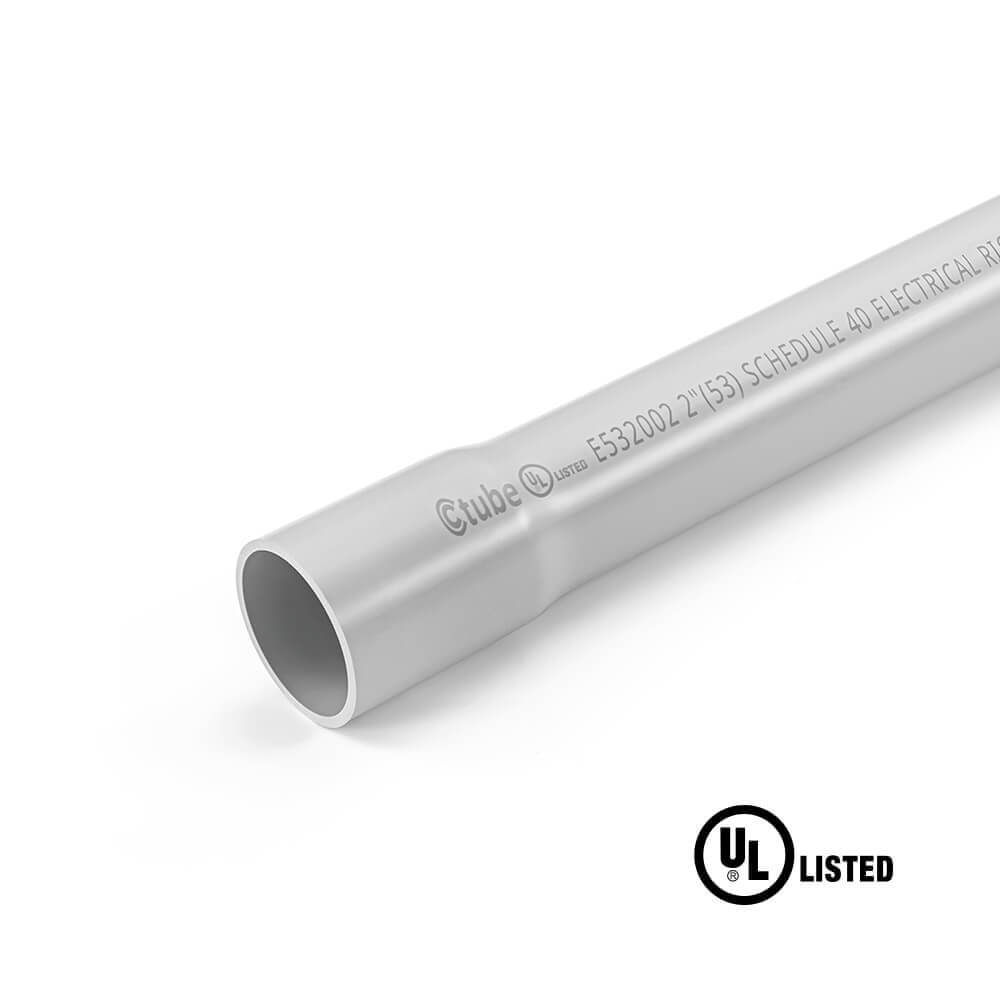
3. Exploring Schedule 40 Conduit: Benefits and Uses
3.1 What is Schedule 40 Conduit
Schedule 40 conduit is a type of polyvinyl chloride (PVC) conduit widely used in electrical installations. The term “Schedule 40” refers to a standardized system used to specify the wall thickness of pipes and tubing. It is known for its strength and versatility, making it suitable for a variety of applications in both residential and commercial settings.
A conduit schedule refers to a standardized system used to specify the wall thickness of pipes and tubing. It is an essential aspect of conduit design and selection, providing a way to precisely communicate the thickness of a conduit’s wall based on its nominal size and intended application.
The schedule number – represented as “sch” followed by a numerical value such as 40 or 80 – indicates the wall thickness of the conduit. Lower schedule numbers indicate thinner walls, while higher schedule numbers represent thicker walls. For example, a schedule 40 conduit will have a thicker wall compared to a schedule 80 conduit of the same nominal size.
3.2 Material and Design Specifics
Material: Schedule 40 conduit is made from high-quality polyvinyl chloride (PVC), a thermoplastic material that offers excellent resistance to moisture, chemicals, and corrosion. PVC’s durability ensures long-term protection for electrical cables against environmental factors.
Design: The conduit features a smooth interior surface, which minimizes friction and facilitates the easy pulling of wires through long sections. This smoothness is crucial for protecting the integrity of electrical cables during installation. Schedule 40 conduit typically comes in standard 10-foot or 20-foot sections, with ends that may be plain or bell-shaped for easy connection. The conduit is available in a range of diameters, allowing it to accommodate various sizes of electrical cables.
3.3 Key Technical Specifications
– The Schedule 40 PVC conduit meets the standards set by UL651 and NEMA TC-2. It is also compliant with CSA, ETL, and ASTM regulations.
Wall Thickness: Schedule 40 conduit has a wall thickness of approximately 0.109-0.322. The thickness increases with the diameter to maintain strength and durability.
– Impact Resistance: With a tensile strength of 5,000 psi, the SCH 40 offers superior resilience, making it ideal for installations where durability is crucial. This strength ensures that it can withstand significant pressure and forces without compromising its structural integrity.
– Temperature Range: Suitable for use in a wide range of temperatures, typically from -4°F to 140°F (-20°C to 60°C), ensuring reliable performance in various climatic conditions.
– UV Resistance: Some Schedule 40 conduit is UV resistant, making it suitable for outdoor aboveground installations where exposure to sunlight is a factor.
– Lengths and Sizes: Available in standard lengths, commonly 10-foot or 20-foot sections, with diameters ranging from 1/2 inch to 8 inches. This variety provides flexibility to meet different installation requirements.
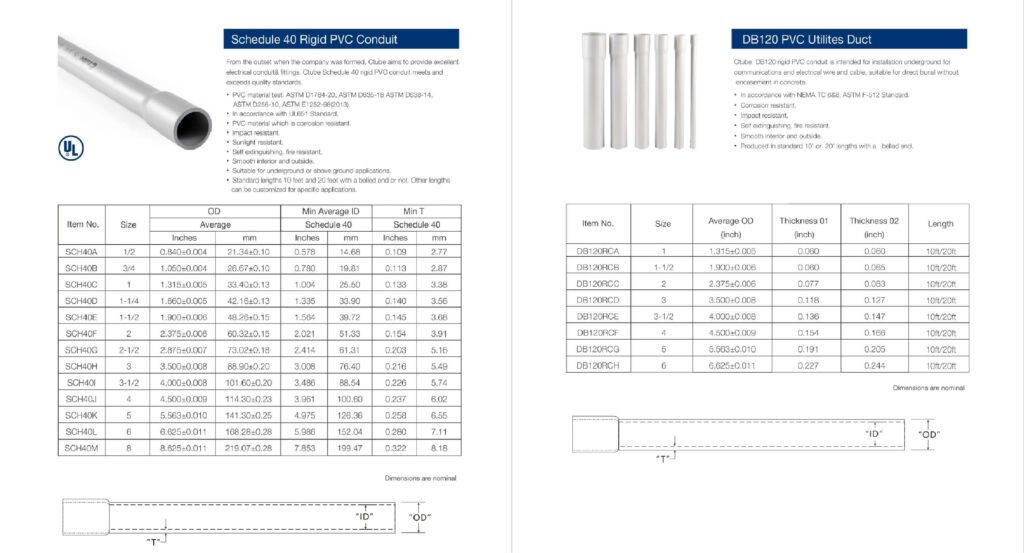
4.DB120 Conduit vs Schedule 40 Conduit: Detailed Comparison
4.1 Comparison of key features
1. Wall Thickness and Weight
– SCH 40 Conduits have significantly thicker walls compared to DB120 conduits for all sizes. The wall thickness difference varies from 0.036 inches to 0.098 inches, depending on the size.
– SCH 40 Conduits are heavier due to their thicker walls, which might make them more challenging to handle and install compared to DB120 conduits.
2. Strength and Durability
– SCH 40 Conduits: Due to the thicker walls, SCH 40 conduits are stronger and more durable. They can withstand higher pressures and more mechanical stress compared to DB120 conduits.
– DB120 Conduits: These conduits are less strong and durable due to their thinner walls, making them less suitable for high-pressure and high-stress applications.
3. Cost Consideration
SCH 40 Conduits
– Material Costs: Higher material costs due to thicker walls and more robust construction.
– Installation Costs: Installation might be more labor-intensive due to the weight and rigidity of the conduits, potentially increasing labor costs.
– Long-Term Value: Higher initial costs are offset by greater durability and longer lifespan, reducing the need for replacements and repairs.
DB120 Conduits
– Material Costs: Lower material costs due to thinner walls and lighter construction.
– Installation Costs: Easier and faster to install due to lighter weight, reducing labor costs and installation time.
– Long-Term Value: While less expensive initially, they may not provide the same long-term durability and protection as SCH 40 conduits, possibly leading to higher maintenance costs over time.
4.2 Comparison of standard requirements
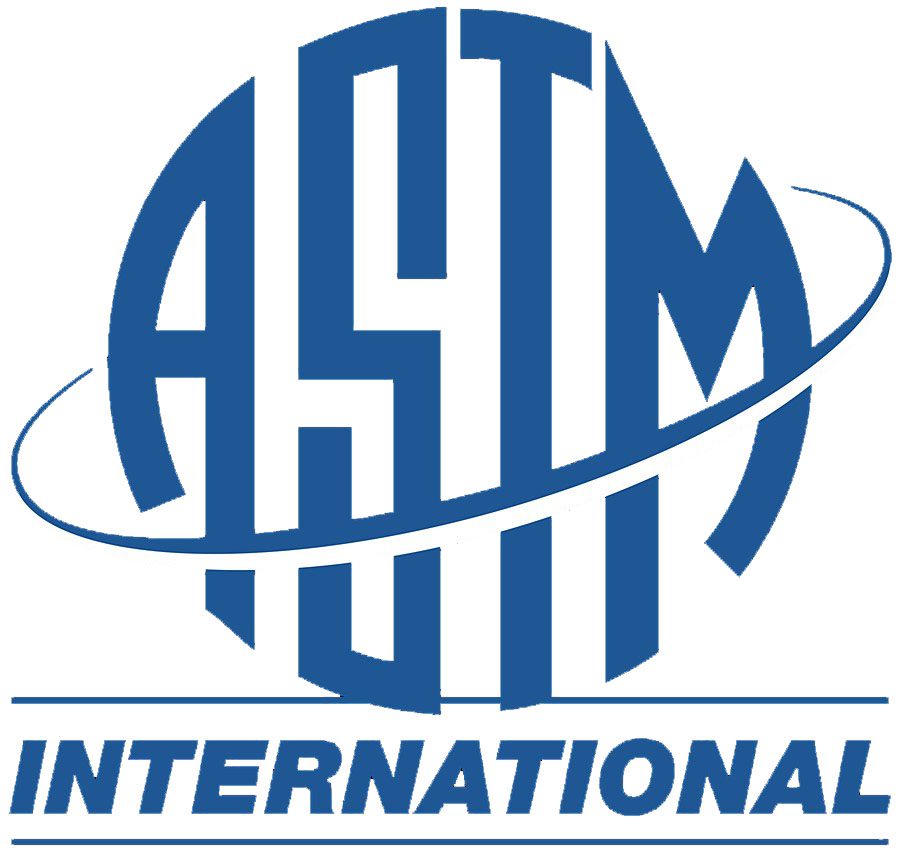
4.2.1 Adhere to the common labels
ASTM F512: This standard specification addresses smooth-wall polyvinyl chloride (PVC) conduit used for electrical applications. Both DB-120 and Schedule 40 conduits can be covered under this standard, providing guidelines on dimensions and material properties.
ASTM D1784: This standard specification covers PVC plastic pipes (Schedules 40, 80, and 120) for pressure applications. While it primarily deals with pressure ratings, it includes dimensions and specifications that can be applied to conduits used for electrical purposes, including Schedule 40.
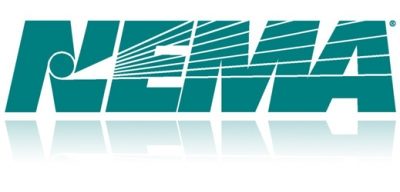
4.2.2 DB120 Conduit also meet
NEMA TC-6: This standard pertains to PVC and ABS plastic utilities for underground installation. It includes specifications for conduits like DB-120, ensuring they are suitable for direct burial applications.
NEMA TC-8: This standard covers the requirements for conduit and fittings used in underground installations, which can include DB-120 conduits for direct burial.
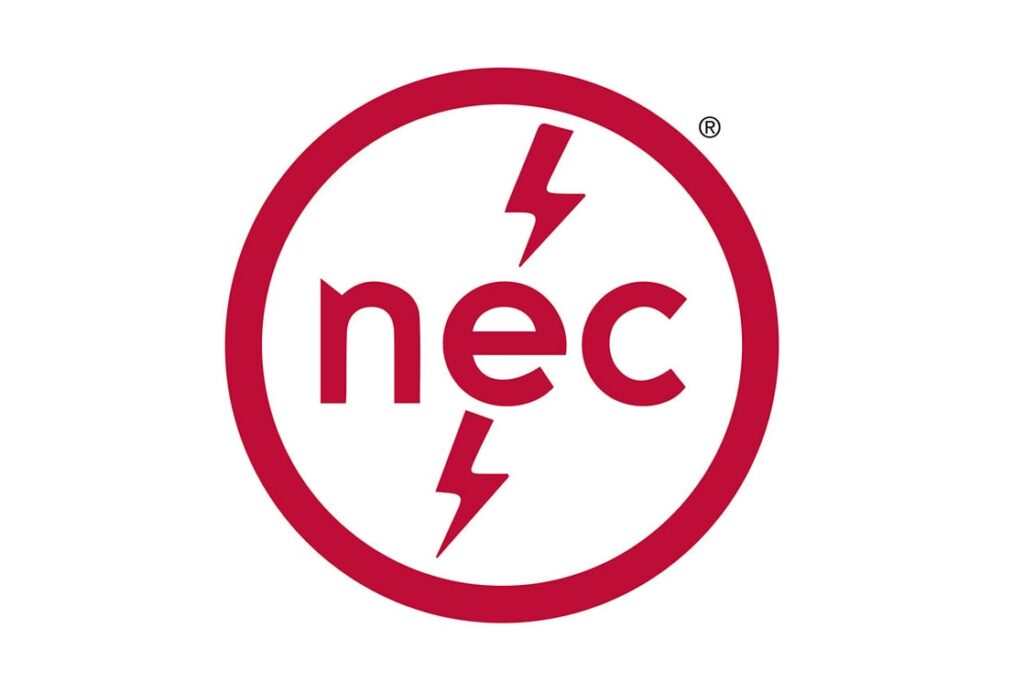
4.2.3 Sch 40 conduit is mentioned in
ASTM D1784: This standard specification covers the classification system for rigid polyvinyl chloride (PVC) compounds used to manufacture pipes and fittings. It specifies the physical properties and tests required to ensure the material’s suitability for various applications, including electrical conduit.
NEMA TC-2: This standard covers the requirements for rigid nonmetallic conduit (RNC), including Schedule 40 and Schedule 80. It ensures these conduits meet the necessary requirements for strength, durability, and safety.
NEMA TC-3: This standard specifies the fittings associated with the conduits covered in NEMA TC-2, ensuring compatibility and performance.
NEC: Schedule 40 PVC Conduit electrical pipe is used for electrical wiring in walls, floors and ceilings in accordance with NEC 352. According to NEC 352 it can also be buried directly into the earth, encased in concrete, and used in areas exposed to direct sunlight.
UL651: UL 651 specifies the dimensions, including wall thickness and diameter, for Schedule 40 and Schedule 80 conduits. It ensures the conduits have sufficient mechanical strength for their intended applications.
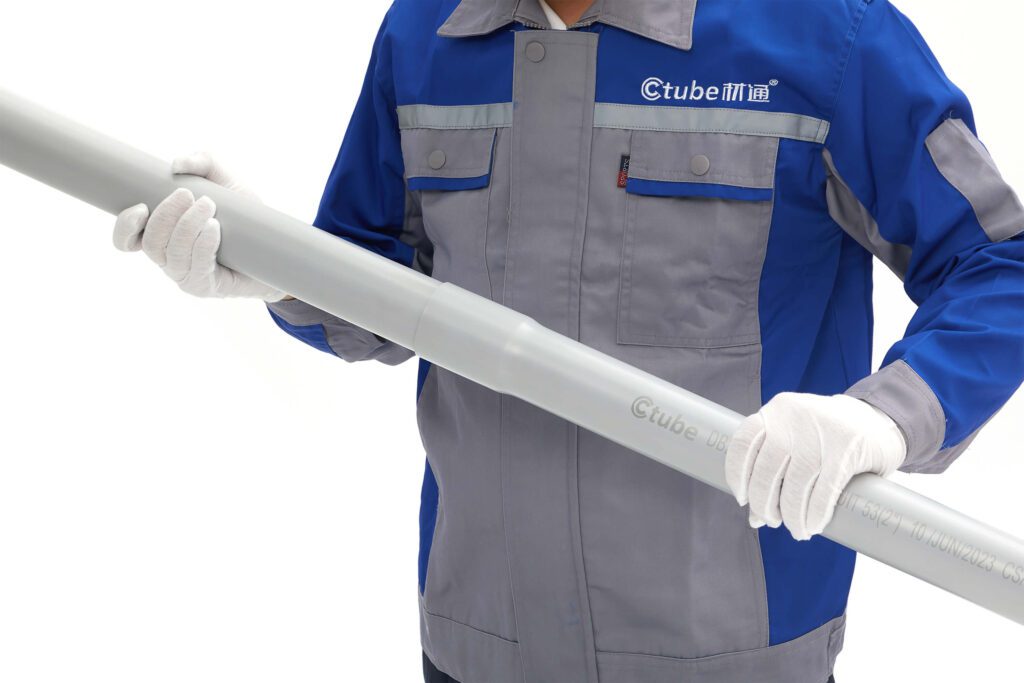
4.3 Comparison of different application
SCH 40 Conduits
Heavy-Duty Electrical Runs: Ideal for electrical runs in industrial settings where conduits are exposed to high traffic, potential impacts, and harsh environmental conditions.
Utility Installations: Commonly used in utility installations where conduits need to withstand heavy loads and potential physical damage.
Infrastructure Projects: Suitable for infrastructure projects such as bridges and tunnels where high durability and strength are required.
DB 120 Conduits:
Residential Electrical Runs: Often used in residential settings for underground electrical runs where heavy-duty protection is not required.
Light Commercial Installations: Suitable for light commercial applications where weight and ease of installation are prioritized over high mechanical strength.
Temporary Installations: Can be used in temporary installations where ease of handling and cost-effectiveness are more critical than long-term durability.
5. Conduit Installation for Direct or Concrete buried
SCH 40 Conduits: Suitable for both above-ground and below-ground applications, including direct burial and concrete encasement.
DB120 Conduits: More suitable for direct burial applications
5.1 Conduit Installation for Direct Burial
5.1.1 Trench Width
– The width of the trench at the surface level can vary based on factors such as soil type, equipment used, and nearby surface structures.
– When initial backfill compaction is necessary, the trench should be at least five times the diameter of the pipe.
– For very wide trenches, sub-ditching can enhance side support for the conduit.
– Use shoring or trench boxes to protect workers in loose soil or deep trenches.
5.1.2 Trench Bottom
– The bottom of the trench must provide firm, stable, and uniform support for the entire length of the conduit.
– Unless specified otherwise, line and grade are not mandatory, as long as the conduit conforms to the trench bottom and bending limits in Section 3.7 are not exceeded.
– Remove large rocks, boulders, frozen soil clumps, and large clay lumps before placing the conduit.
– Use loose backfill or sand to bed rocky or uneven trench bottoms, creating a soft, even cushion for the conduit.
5.1.3 Initial Backfill
– The initial backfill material should be dry, free-flowing, and free of rocks larger than 1 inch in diameter.
– Apply the initial backfill in thin layers of 3 to 6 inches, spreading it uniformly.
– Tamp each layer of backfill up to the conduit’s springline.
– In installations with multiple conduits, carefully place the initial backfill between ducts and under haunches.
– Tamping should occur between the trench edges over the springline but not directly over the conduit.
– Place the initial backfill loosely over the top of the conduit to a depth of 6 inches.
– Complete all tamping or flooding compaction before adding the final backfill.
5.1.4 Final Backfill
– After embedding and compacting conduit materials, the remaining backfill can be added using machinery.
– Ensure the final backfill does not contain large rocks, stones, frozen material, or debris.
– Follow proper compaction procedures to achieve the necessary soil density.
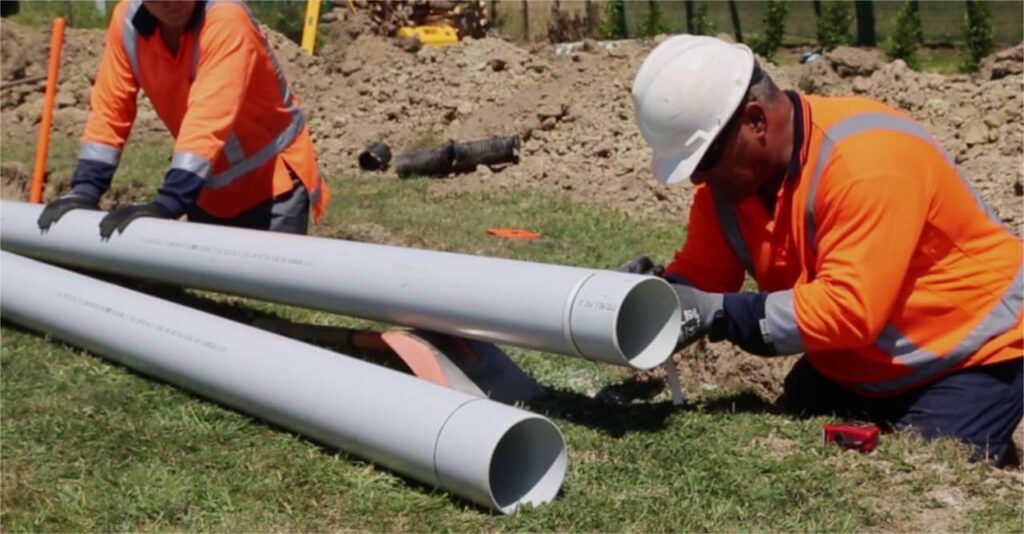
5.2 Conduit Installation for Concrete Encasement
5.2.1 Securing Conduit
– All conduit should be securely tied and fastened to prevent it from floating.
– When concrete is used in the trench bottom, ensure at least a 2-inch gap between the conduit and any tie-down equipment.
5.2.2 Spacers
– Use spacers at intervals specified or less as shown in the guidelines.
– Maintain a minimum spacing of 1 inch for all conduit.
– For encasement, use a concrete mix with pea gravel.
– In areas requiring bends, such as freeway or water crossings, maintain a minimum spacing of 2 inches.
5.2.3 Concrete Coverage
– Ensure a minimum of 2 inches of concrete coverage on the top, bottom, and sides of the conduit.
– Firm soil conditions might negate the need for concrete at the trench bottom.
5.2.4 Backfilling
– Backfilling can commence once the concrete has cured sufficiently to support the weight of a person.
5.2.5 Temperature Considerations
– Be aware that curing concrete can cause temperature-related expansion of the conduit.
– Pour concrete from the center of the run towards each free end or from one tie-in point towards the free end of the conduit.
– Make permanent terminal tie-ins only after the temperature has stabilized.
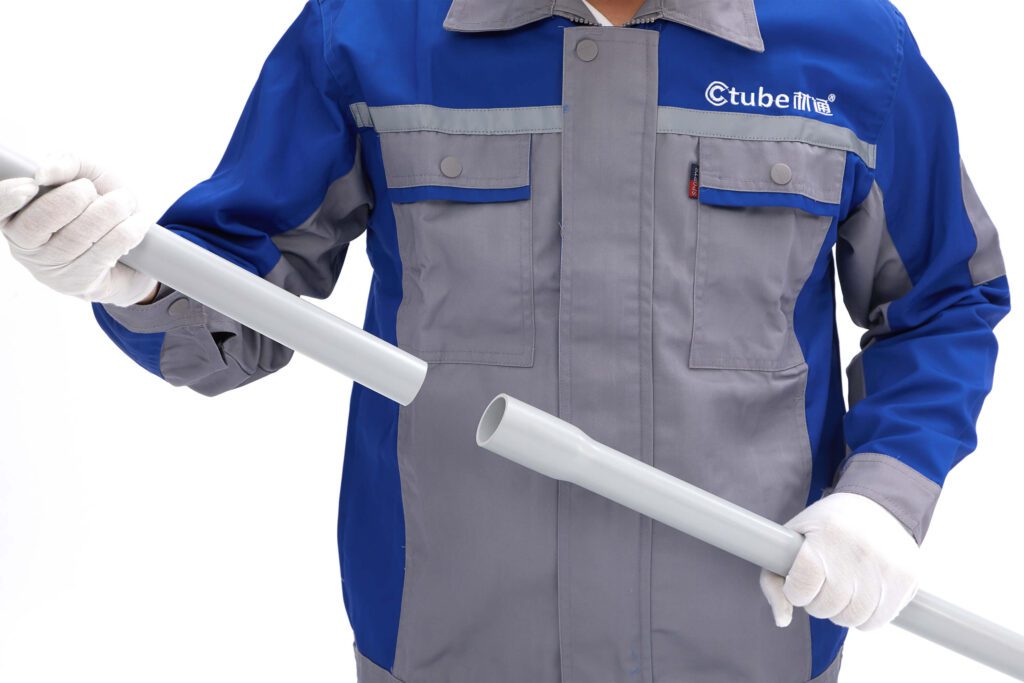
6. Conclusion: Choosing Between DB120 Conduit and SCH 40 Conduit
When deciding between DB120 conduit and SCH 40 conduit, consider the specific requirements of your project. DB120 conduit, known for its lighter weight and cost-effectiveness, is ideal for low-stress applications such as underground installations for electrical and telecommunications cables. It’s easier handling and installation make it a popular choice for these scenarios. On the other hand, SCH 40 conduit is thicker and more robust, providing superior durability and resistance to physical damage. This makes it suitable for more demanding environments, including above-ground installations and areas with higher mechanical stress. Ultimately, the choice hinges on balancing factors like environmental conditions, installation requirements, and budget constraints.
Ctube is PVC conduit manufacturer in China, dedicated to the development and production of advanced plastic conduits and fittings. Our expertise lies in creating innovative solutions for cable management and protection, ensuring high performance and reliability. With a focus on quality and precision, we offer a comprehensive range of products tailored to meet diverse project requirements, from lightweight and cost-effective DB120 conduits to robust and durable SCH 40 conduits. At Ctube, we are committed to delivering excellence in cable protection and management solutions to our global clientele.

